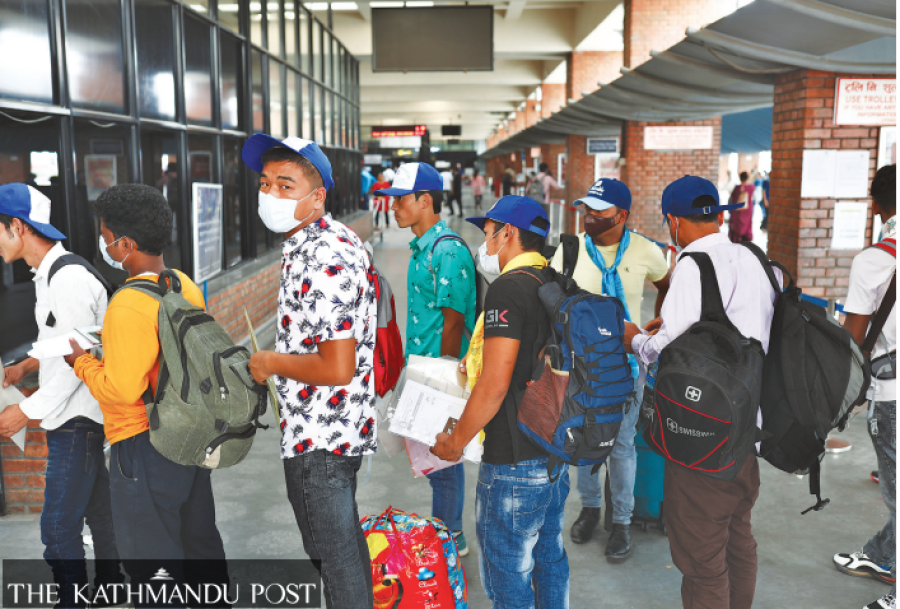Money
Migrant workers biggest moneymakers, but the country doesn’t care enough
Nepal’s weak diplomacy has been a big barrier to addressing labour exploitation at work destinations.
Pawan Pandey
Nepali migrant workers sent home more than Rs1 trillion in the past fiscal year, making remittance a lifeline for the country’s ailing economy.
Remittance now ranks above foreign development assistance, foreign direct investment and private investments, combined, as a source of income for the country.
But exploitation of Nepali migrant workers is increasing as fast.
Migrant workers are three times more likely to be in forced labour than non-migrant adult workers, even though it has been decades since the abolition of slavery, according to a recent report entitled Global Estimates of Modern Slavery.
Fifty million people—or one in every 150 worldwide—are in situations of slavery globally, said the report jointly published by the International Labour Organisation, Walk Free and the International Organisation for Migration.
The report said that 28 million workers were in forced labour, and 22 million were trapped in forced marriages. More than 3.3 million of them are children.
Labour experts say that thousands of Nepalis face exploitation and forced labour when working in countries around the world. Nepal's weak diplomacy has been a barrier to addressing labour exploitation issues.
Nepalis are travelling abroad en masse due to limited job opportunities at home due to prolonged political instability.
Labour migration can be beneficial, with remittances covering household expenses, including education, healthcare or savings, but exploitation and abuse of Nepali workers have remained unaddressed, experts say.
“Obviously, we need a strong diplomatic initiative to address labour exploitation issues,” said Rameshwar Nepal, executive director of Equidem Research Nepal, a human rights and labour rights research organisation.
“The poor working conditions of Nepali migrant workers became apparent during the Covid-19 pandemic,” said Nepal. “Our diplomatic missions need a complete overhaul to address labour issues.”
Nepal said that labour exploitation is rampant right from the recruitment phase. “Our labour governance is weak to intercept labour rights violations.”
Commonly reported complaints include contract breaches, limited freedom of movement, non-payment of wages and confiscation of identity documents.
Last month, nearly five dozen Nepali workers were deported from Qatar for allegedly joining a protest demanding their back pay.
“Migrant workers who are not protected by law or are unable to exercise their rights, face a higher risk of forced labour than other workers,” the report said. “The forced labour prevalence of adult migrant workers is more than three times higher than that of adult non-migrant workers.”
Modern slavery, as defined in the report, comprises two principles—forced labour and forced marriage.
Both refer to situations of exploitation that a person cannot refuse or cannot leave because of threats, violence, coercion, deception or abuse of power.
In the Covid era or in 2021, around 10 million more people were in modern slavery as compared to 2016 global estimates, the report said. Women and children remain disproportionately vulnerable.
The report suggests modern slavery can be ended by improving and enforcing laws and labour inspections; ending state-imposed forced labour; stronger measures to combat forced labour and trafficking in business and supply chains; extending social protection, and strengthening legal protections.
The report has suggested raising the legal age of marriage to 18 without exception.
Other measures include addressing the increased risk of trafficking and forced labour for migrant workers, promoting fair and ethical recruitment, and greater support for women, girls and vulnerable individuals, according to the report.
In the last fiscal year, 637,113 Nepalis were issued labour permits, the second highest figure in history.
The highest number of labour approvals was 642,859 in the fiscal year 2016-17, according to the Department of Foreign Employment statistics. The rise, according to experts, was due to an increase in poverty immediately after the 2015 earthquake.
The government issued labour permits to 76,403 individuals last month—from mid-August to mid-September. The trend shows that by the end of this fiscal year, the number of Nepalis migrating abroad could touch the 1 million mark.
Migration is a push factor basically caused by climatic and political factors.
"In Nepal’s case, it is apparently a political factor," said Jeevan Baniya, assistant director at the Centre for Study of Labour and Mobility, Social Science Baha, a non-profit involved in research in the social sciences in Nepal.
For the country which struggled for stable governments, there were hopes that the Nepal Communist Party, which was elected to power with a resounding majority in 2017, would increase jobs and opportunities by utilising the country’s resources.
The powerful government plunged into crisis, putting the country into a state of uncertainty.
“The migrant workers who had returned to Nepal during the Covid pandemic are back in their job destinations,” said Baniya. “This number may rise because of the low development activities here.”
Along with the numbers, the unstable government is not worried about workers' safety, say insiders. They said that the compensation provided for death and serious injuries was nominal.
The Foreign Employment Board statistics show that since 2008-09, families of more than 11,200 workers have received compensation for their deaths. Over 2,200 workers have received compensation for injuries.
The government says it is working to ensure the safety of migrant workers by allowing people to travel to countries with which Nepal has a bilateral labour agreement.
“The safety of migrant workers has always been our priority,” said Thaneshwar Bhusal, deputy spokesperson for the Ministry of Labour, Employment and Social Security. “We have a range of interventions, most of which are implemented, to ensure Nepalis workers are safe in their workplaces.”
According to Bhusal, pre-departure orientation programmes are the best tool to ensure workplace safety tutorials are provided to migrant workers in advance. “There is, however, a question of the effectiveness of such tools,” he said.
The orientation programmes are poorly implemented, say experts.
A new curriculum was introduced to provide country-specific information for outgoing labourers through an audio-visual medium, but it remains unimplemented.
Organisations responsible for providing such training say they cannot implement the new curriculum by following the existing working procedure.
Raja Ram Gautam, president of the Federation of Foreign Employment Orientation Associations Nepal, told the Post in a recent interview that they had been providing the same orientation training for the past one decade.
“Our embassies and diplomatic missions in labour destinations have limited themselves to carrying out administrative work,” Ganesh Gurung, a senior labour migration expert, told the Post in a recent interview.
Under-secretary Bhusal argues that diplomatic missions are actively monitoring Nepali migrant workers' wellbeing. “But the diplomatic missions are severely strained in terms of human and capital resources.”




 10.12°C Kathmandu
10.12°C Kathmandu














